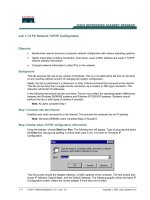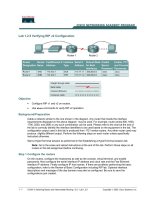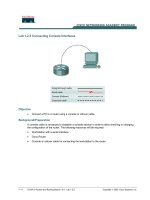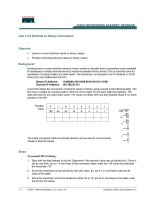Tài liệu Lab 1.2.6 Binary to Decimal Conversion pptx
Bạn đang xem bản rút gọn của tài liệu. Xem và tải ngay bản đầy đủ của tài liệu tại đây (119.61 KB, 2 trang )
Lab 1.2.6 Binary to Decimal Conversion
Objective
• Learn the process of converting binary values to decimal values.
• Practice converting binary values to decimal values.
Background
The following is an example of an IP address in 32-bit binary form and dotted decimal form.
Binary IP Address: 11000000.10101000.00101101.01111001
Decimal IP Address: 192.168.45.121
Binary data is made up of ones and zeros. Ones represent on and zeros represent off. Binary data
can be grouped in varying increments, 110 or 1011. In TCP/IP binary data is usually grouped in eight
digit groups called a Byte.
A Byte, 8 bits, can range from 00000000 to 11111111 creating 256 combinations with decimal values
ranging from 0 to 255. IP addressing uses 4 bytes, or 32 bits, to identify both the network and
specific device. The specific device can be a node or host. The example at the beginning of this lab
is an example of an IP address in both binary decimal formats.
A tool that makes the conversion of binary to decimal values simple is the following table. The first
row is created by counting right to left from one to eight for the basic eight bit positions. The tale will
work for any size binary value. The value row starts with one and doubles, base 2, for each position
to the left.
8 7 6 5 4 3 2 1
128 64 32 16 8 4 2 1
Position
Value
Steps
1. Enter the binary bits in row three. For example 10111001
2. Put the decimal values in row four only for the third row 1s. Technically the row two values are
being multiplied by row three.
3. Now just add row four across.
8 7 6 5 4 3 2 1
128 64 32 16 8 4 2 1
1 0 111001
128 32 16 8 1
Position
Value
= 185
1 - 2 CCNA 1: Networking Basics v 3.0 - Lab 1.2.6 Copyright 2003, Cisco Systems, Inc.
4. Convert the following binary values to decimals:
a. 1110
_______________________
b. 100110
_______________________
c. 11111111
_______________________
d. 11010011
_______________________
e. 01000001
_______________________
f. 11001110
_______________________
g. 01110101
_______________________
h. 10001111
_______________________
i. 11101001.00011011.10000000.10100100
_________________ _________________ _________________ _________________
j. 10101010.00110100.11100110.00010111
_________________ _________________ _________________ _________________
2 - 2 CCNA 1: Networking Basics v 3.0 - Lab 1.2.6 Copyright 2003, Cisco Systems, Inc.









